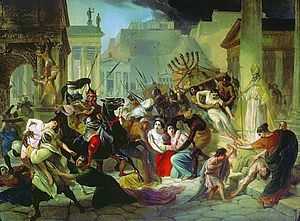Sack of Rome (455)
| Sack of Rome | |||||||
|---|---|---|---|---|---|---|---|
| Part of Fall of Western Roman Empire | |||||||
 Genseric sacking Rome | |||||||
| |||||||
| Belligerents | |||||||
| Western Roman Empire | Vandal Kingdom | ||||||
| Commanders and leaders | |||||||
| Petronius Maximus | Genseric | ||||||
The sack of 455 was the second of three sacks of Rome; it was conducted by the Vandals, who were then at war with the usurping Western Roman Emperor Petronius Maximus.
In the 440s, the Vandal king Genseric and the Roman Emperor Valentinian III, had betrothed their children, Huneric and Eudocia,[1] to strengthen their alliance, reached in 442 with a peace treaty (the marriage was delayed as Eudocia was too young). In 455 Valentinian was killed, and Petronius Maximus rose to the throne. Petronius married Valentinian's widow, Licinia Eudoxia, and had his son Palladius marry Eudocia; in this way Petronius was to strengthen his bond with the Theodosian dynasty. This move, however, damaged Genseric's ambitions. The king of the Vandals claimed that the broken betrothal between Huneric and Eudocia was an invalidation of his peace treaty with Valentinian, and set sail to attack Rome.
Upon the Vandal arrival, according to the chronicler Prosper of Aquitaine, Pope Leo I requested that Genseric not destroy the ancient city nor murder its inhabitants. Genseric agreed and the gates of Rome were thrown open to him and his men. Maximus, who fled rather than fight the Vandal warlord, was killed by a Roman mob outside the city,[2] possibly together with his son Palladius.
It is accepted that Genseric looted great amounts of treasure from the city, damaging objects of cultural significance such as the Temple of Jupiter Optimus Maximus by stripping away the gilt bronze roof tiles (hence the modern term vandalism[3] ), and also took Licinia Eudoxia and her daughters hostage.[4] Eudocia later married Huneric. There is, however, some debate over the severity of the Vandal sack. The sack of 455 is generally seen as being more thorough than the Visigothic sack of 410,[5] because the Vandals plundered Rome for fourteen days whereas the Visigoths spent only three days in the city.
The cause of most controversy, however, is the claim that the sack was relatively "clean", in that there was little murder and violence, and the Vandals did not burn the buildings of the city. This interpretation seems to stem from Prosper's claim that Leo managed to persuade Genseric to refrain from violence. However, Victor of Vita records how many shiploads of captives arrived in Africa from Rome, with the purpose of being sold into slavery. Similarly, the Byzantine historian Procopius reports that at least one church was burnt down.
Notes
- ↑ Peter Heather, The Fall of the Roman Empire: A New History of Rome and the Barbarians, (Oxford University Press, 2006), 378.
- ↑ Peter Heather, The Fall of the Roman Empire: A New History of Rome and the Barbarians, 378-379.
- ↑ Encyclopaedia Britannica, cited in Online Etymology Dictionary (13 ed.). Encyclopaedia Britannica. 1926.
- ↑ Peter Heather, The Fall of the Roman Empire: A New History of Rome and the Barbarians, 378.
- ↑ Peter Heather, The Fall of the Roman Empire: A New History of Rome and the Barbarians, 379.
References
- Procopius, 'The Vandalic War' in The History of the Wars, Books III & IV, trans. H.B Dewing (Cambridge; Mass. 1916)
- Muhlberger, S., The Fifth Century Chroniclers: Prosper, Hydatius and the Gallic Chronicler of 452 (Leeds, 1990) — for Prosper's hagiographic portrayal of Leo.
- Victor of Vita, History of the Vandal Persecution, trans. J. Moorhead (Liverpool, 1992).
- Ward-Perkins, B., The Fall of Rome and the End of Civilisation (Oxford, 2005) pp. 17 & 189.